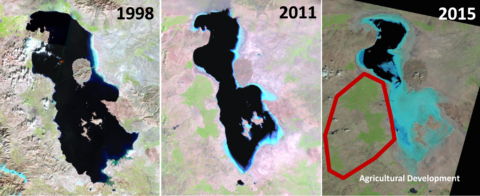Imagine the Sahara Desert, but with grasslands, wetlands, eclectic wildlife, and an intricate ecosystem lushly nestled around a large freshwater lake the size of Germany. Around 6,000 years ago, Lake Mega-Chad was the largest freshwater lake on Earth. In just a few hundred years, it was reduced to a lake around a thousand times smaller, and what we know today as Lake Chad. This is an example of significant change in water availability in response to natural climate variability. In the Anthropocene era, however, natural variability is not the primary driver of the observed water stress and environmental degradation. They are human driven, or anthropogenic.
Development and growth not only increases human water use, but also increases greenhouse gas emissions that, in the long run alter precipitation patterns.
Since the beginning of industrialization, significant growth in population, agriculture, and industry have increased water use and challenged water and environmental management. In many parts of the world, human water use has exceeded available renewable water supply. Development and growth not only increases human water use, but also increases greenhouse gas emissions that, in the long run alter precipitation patterns. Droughts pose significant water and food security challenges, especially in semiarid and arid regions of the world. Droughts can be broadly categorized into four groups: meteorological droughts (deficit in precipitation), agricultural droughts (deficit in soil moisture), hydrologic droughts (deficit in runoff and/or groundwater resources), and socio-economic droughts (higher demand than the available supply). The latter is meant to account for the human impacts on droughts by describing the available resources relative to human water needs. However, a meaningful exploration of drought must go beyond supply issues to include water demands, adaptability, policy, and the two-way feedback of humans on both water supply and regional demands.
In a recent article, we call this anthropogenic drought, which is water stress caused or intensified by human activities, including increased demand, outdated water management, climate change from anthropogenic greenhouse gas emissions, growing energy and food production, intensive irrigation, diminished supplies, and land use change.
The environmental impacts of anthropogenic drought are seen around the world including in developed and developing countries. There are many stressed lakes and wetlands around the world affected by increasing water withdrawals and the resulting anthropogenic drought. For example, Lake Urmia, in northwest Iran, was once the second largest saltwater lake on Earth (figure below). We show in a commentary that over the past 40 years, the area of Lake Urmia has decreased by around 80%, most of the change occurring between 2009-2015. But this lake has survived many extreme droughts in the past. When extreme environmental conditions occur, questions often arise regarding the potential role of human-caused or natural climate change. Both are important and deserve our attention. But a question less often asked is, what is the impact of increased human water demand in creating water stress? In the past 15 years, around 20 man-made dams started operation in Lake Urmia’s basin, diverting the lake’s freshwater inflow to irrigation and farming. Lake Urmia is a hypersaline lake, and its desiccation will increase the frequency of salt storms generated from the exposed lakebed. In turn, salt storms will likely reduce productivity of the surrounding agricultural lands, causing migration out of the region. Poor air, land, and water quality all have serious health effects including birth defects, and chronic respiratory and eye diseases. This is a classic case of anthropogenic drought and human-induced changes leading to substantial environmental degradation.

The first victim of anthropogenic droughts is the natural ecosystem, evidenced by the widespread environmental degradation we see around the world. Extensive research is necessary to develop comprehensive frameworks for assessing anthropogenic drought impacts on the natural ecosystem and wildlife. This is critical if we want to sustain both economic prosperity and productive native ecosystems. A breakthrough in this area will not be possible without close collaboration of policy-makers and an interdisciplinary team of scientists.
—Amir AghaKouchak ([email protected]), Editor, Earth’s Future
Amir AghaKouchak is an editor of Earth’s Future, which is encouraging submissions to the theme issue “Avoiding Disasters: Strengthening Societal Resilience to Natural Hazards.”
Citation:
AghaKouchak, A. (2016), Anthropogenic drought: How humans affect the global ecosystem, Eos, 97, https://doi.org/10.1029/2018EO061985. Published on 31 October 2016.
Text © 2016. The authors. CC BY-NC-ND 3.0
Except where otherwise noted, images are subject to copyright. Any reuse without express permission from the copyright owner is prohibited.

